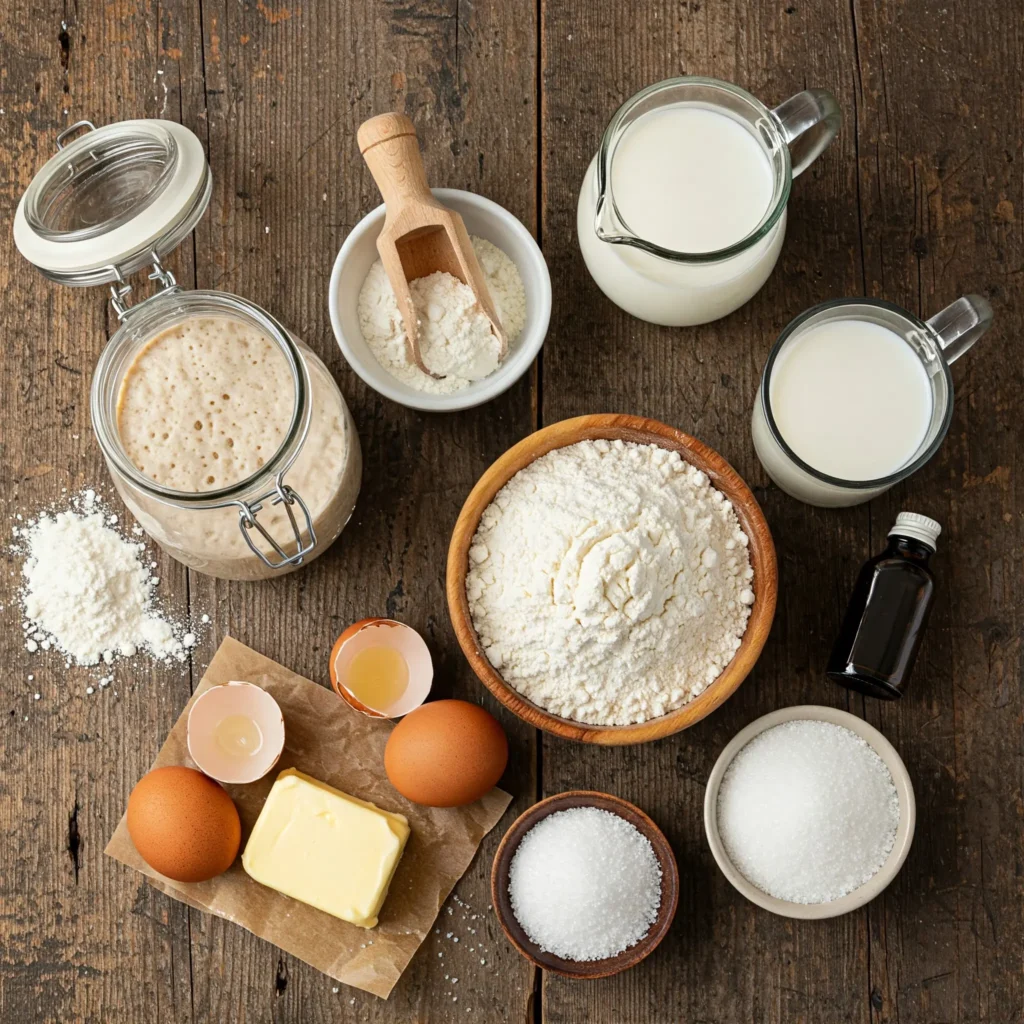I wasn’t expecting much when I tried my first sourdough donut. I figured, It’s just a donut, how special could it be? But then I took a bite. That slight tang, the way it was both airy and perfectly chewy—it stopped me in my tracks. It wasn’t just sweet; it had layers of flavor, something deeper. The kind of taste that makes you slow down and really enjoy it.
Unlike regular donuts that rely on yeast or baking powder to puff up, these beauties take their time. A slow fermentation process gives them that signature chew and complex taste. It’s not just a treat—it’s an experience. The kind of donut that doesn’t just satisfy your sweet tooth but makes you wonder why all donuts aren’t made this way.
And the best part? They’re actually easier on your stomach. Thanks to fermentation, the gluten gets broken down, making them more digestible. Plus, those friendly little bacteria that show up in the process? They do your gut a favor, too. So yeah, sourdough donuts don’t just taste amazing—they might just be the kind of indulgence you don’t have to feel guilty about.

And if you love sourdough, why stop at donuts? You can also try making sourdough tortillas, another delicious way to enjoy the benefits of fermentation.
Key Takeaways
- Sourdough donuts are a delicious and tangy alternative to traditional donuts
- Essential ingredients for mouthwatering sourdough donuts include sourdough starter, flour, sugar, and butter
- Follow a step-by-step guide to making sourdough donuts at home for fluffy and delicious results
- Avoid common mistakes such as overproofing or underproofing the dough when making sourdough donuts
- Get creative with toppings and fillings to customize your sourdough donuts to your liking
What Makes Sourdough Donuts Special?
Sourdough donuts stand out from their traditional counterparts due to their distinctive flavor, texture, and potential health advantages.
Unique Flavor and Texture
You know that slight tang in sourdough bread that makes it so good? Now imagine that in a donut. That’s what makes sourdough donuts stand out—they’re not just sweet, they’ve got depth. Thanks to natural fermentation, they develop a more complex flavor that takes them way beyond your average sugary treat.
But it’s not just about taste. That slow fermentation process also gives them a light, airy texture with just the right amount of chew. Plus, there’s a slightly crisp exterior that makes every bite even more satisfying. Compare that to regular donuts made with commercial yeast—they’re softer, sweeter, and more uniform, but they just don’t have that same character. Sourdough donuts? They bring something extra to the table.
Health Benefits of Sourdough Fermentation
Beyond taste and texture, sourdough fermentation offers several health benefits:
- Improved Digestibility: The fermentation process breaks down gluten and other proteins, making sourdough products easier to digest. This can be particularly beneficial for individuals with mild gluten sensitivities.
- Lower Glycemic Index: Sourdough bread has a lower glycemic index compared to other types of bread, which means it has a more gradual impact on blood sugar levels.
- Enhanced Nutrient Absorption: Fermentation reduces phytic acid, an antinutrient that can inhibit mineral absorption, thereby increasing the bioavailability of nutrients like magnesium, calcium, and iron.
Essential Ingredients for Sourdough Donuts
To embark on your sourdough donut-making journey, gather the following ingredients:
Essential Ingredients for Perfect Sourdough Donuts
To get started on your sourdough donut journey, gather these ingredients:
- Active sourdough starter (1 cup) – Make sure it’s bubbly and active.
- All-purpose flour (3 1/2 cups) – Can be partially substituted with whole wheat flour.
- Milk (1/2 cup) – Warmed to about 100°F (38°C).
- Sugar (1/4 cup) – Adjust sweetness to taste.
- Butter (4 tbsp) – Unsalted, softened or melted.
- Eggs (2) – Adds richness and structure.
- Salt (1/2 tsp) – Enhances flavor.
- Vanilla extract (1 tsp) – For added aroma.
- Neutral frying oil – Such as canola or vegetable oil.

Step-by-Step Guide to Making Sourdough Donuts
1. Prepare the Dough
- Feed Your Starter – Ensure your starter is active by feeding it 4-6 hours before beginning.
- Mix Ingredients – In a large bowl, combine the starter, warm milk, sugar, melted butter, eggs, salt, and vanilla.
- Add Flour – Gradually mix in the flour until a shaggy dough forms.
2. Knead and First Proof
- Knead the Dough – Work the dough for about 8-10 minutes until smooth.
- Let It Rise – Cover and let rise for 4-6 hours until doubled in size.
3. Shape and Second Proof
- Roll Out Dough – Roll to 1/2-inch thickness.
- Cut Donuts – Use a donut cutter or two round cutters.
- Second Rise – Let shaped donuts rise for 1-2 more hours.

4. Fry to Perfection
- Heat Oil – Maintain 350°F (175°C) for even frying.
- Fry in Batches – Cook each donut for 1-2 minutes per side.
- Drain Excess Oil – Use paper towels or a wire rack.
5. Glaze and Serve
- Make a Simple Glaze – Mix powdered sugar, vanilla, and milk.
- Dip and Set – Coat the donuts and let the glaze set.
- Enjoy!
Step-by-Step Guide to Making Sourdough Donuts
Creating sourdough donuts is a rewarding process that involves several stages. Let’s break it down:
1. Prepare the Dough
- Feed Your Starter: Ensure your sourdough starter is active by feeding it 4-6 hours before you begin. It should be bubbly and doubled in size.
- Mix Ingredients: In a large bowl, combine the active sourdough starter, warm milk, sugar, melted butter, eggs, salt, and vanilla extract. Mix until well combined.
- Add Flour: Gradually add the all-purpose flour, mixing until a shaggy dough forms.
2. Knead and Proof
- Knead the Dough: Transfer the dough to a lightly floured surface and knead for about 8-10 minutes until it becomes smooth and elastic.
- First Rise: Place the dough in a greased bowl, cover it with a damp cloth or plastic wrap, and let the dough undergo bulk fermentation sourdough, a process where the dough rises as a single mass. Place it in a lightly greased bowl, cover, and let it rest in a warm place for 4–6 hours, or until doubled in size. This step is crucial for developing the dough’s flavor and structure.
3. Shape and Second Proof
- Roll Out Dough: Once risen, punch down the dough and roll it out on a floured surface to about 1/2-inch thickness.
- Cut Donuts: Use a donut cutter or two round cutters of different sizes to cut out the donuts and holes.
- Second Rise: Place the cut donuts on a parchment-lined baking sheet, cover, and let them rise for another 1-2 hours, or until slightly puffy.
4. Fry the Donuts
- Heat Oil: In a heavy-bottomed pot or deep fryer, heat the oil to 350°F (175°C). Use a thermometer to maintain consistent temperature.
- Fry Donuts: Carefully place a few donuts into the hot oil, avoiding overcrowding. Fry each side for about 1-2 minutes, or until golden brown.
- Drain: Remove the donuts using a slotted spoon and place them on a wire rack lined with paper towels to drain excess oil.

5. Glaze and Serve
- Prepare Glaze: While the donuts cool slightly, prepare a simple glaze by mixing powdered sugar, vanilla extract, and enough milk to achieve your desired consistency.
- Dip Donuts: Dip the warm donuts into the glaze, allowing excess to drip off, and place them back on the wire rack to set.
- Enjoy: Once the glaze has set, your sourdough donuts are ready to be enjoyed!
Tips for Perfect Sourdough Donuts
Achieving donut perfection is all about attention to detail. Here are some pro tips:
Monitor Oil Temperature: Keep the frying oil at a steady 350°F (175°C) to ensure even cooking and prevent greasy donuts.
Use an Active Starter: An active, bubbly starter is crucial for proper fermentation and rise.
Don’t Overwork the Dough: Over-kneading can develop too much gluten, resulting in tough donuts.
Healthier Option: Baked Sourdough Donuts

If you’re looking for a healthier option, try making baked sourdough donuts instead of frying them. While fried donuts are undeniably delicious, baking reduces the amount of oil absorbed during cooking, cutting down on calories and fat. Baked sourdough donuts still have that signature tangy flavor and fluffy texture, but they’re lighter and easier on the stomach. Plus, baking allows you to experiment with different flavors and toppings without the mess of frying. Whether you’re health-conscious or just want to try something new, baked sourdough donuts are a fantastic alternative that doesn’t compromise on taste!
Common Mistakes to Avoid
Even experienced bakers can run into challenges when making sourdough donuts. Here are some common mistakes and how to avoid them:
- Inactive Starter: If your starter isn’t bubbly and active, your donuts may not rise properly. Always feed your starter ahead of time and use it at its peak.
- Overproofing or Underproofing: Proofing too long can cause the dough to collapse, while underproofing results in dense donuts. Look for a slight puffiness before frying.
- Inconsistent Oil Temperature: Too hot, and your donuts will burn on the outside while staying raw inside. Too cool, and they’ll absorb excess oil. Use a thermometer to maintain 350°F (175°C).
- Overcrowding the Fryer: Frying too many donuts at once lowers the oil temperature, leading to uneven cooking. Fry in small batches for best results.
Creative Ways to Top and Fill Your Donuts
Once you’ve mastered the basic sourdough donut, you can get creative with toppings and fillings. Here are some fun ideas:

Topping Ideas
- Classic Glaze: A simple mix of powdered sugar, milk, and vanilla.
- Cinnamon Sugar: Toss warm donuts in a mix of cinnamon and granulated sugar.
- Chocolate Ganache: Dip donuts in a rich chocolate glaze.
- Powdered Sugar: A light dusting for a classic touch.
- Maple Glaze with Bacon: Sweet and savory for an extra treat.
Filling Ideas
- Pastry Cream: Classic vanilla custard for a creamy center.
- Fruit Jams: Raspberry, strawberry, or blueberry for a fruity burst.
- Nutella or Chocolate Cream: For chocolate lovers.
- Lemon Curd: A bright and tangy filling.
- Pumpkin Spice Cream: Perfect for fall flavors.
FAQs About Sourdough Donuts
Can I Use Whole Wheat Flour?
Yes! You can substitute part or all of the all-purpose flour with whole wheat flour. Keep in mind that whole wheat absorbs more liquid, so you may need to adjust hydration levels.
How Long Does Proofing Take?
Proofing time depends on temperature and starter activity. Generally, expect the first rise to take 4-6 hours and the second rise 1-2 hours.
Can I Bake Instead of Fry?
Yes, but baked donuts will have a different texture. To bake, preheat the oven to 375°F (190°C) and bake for 12-15 minutes, then glaze as desired.
How Do I Store Sourdough Donuts?
Store leftover donuts in an airtight container at room temperature for up to two days. For longer storage, freeze and reheat before serving.
Why Sourdough Donuts Are Worth the Effort
Sourdough donuts require patience, but the payoff is a rich, tangy, and delightfully fluffy treat that’s worth the wait. The fermentation process not only enhances the flavor but also makes them easier to digest. Plus, the ability to customize toppings and fillings means endless variety!
Ready to give it a try? Gather your ingredients, start your sourdough, and enjoy the magic of homemade sourdough donuts. Let us know your favorite variations and share your creations!



